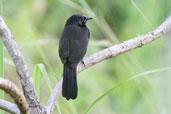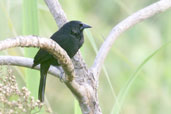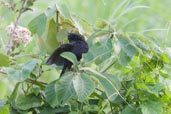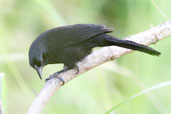(aka Curaeus forbesi)
Brazilian name: Anumará




Another difference with Chopi Blackbird is the voice.
Ciro Albano managed to get an excellent video of a displaying bird at what I assume is the same site.
| Previous Page | Back to Index | Next Page |
| Forbes's Blackbird Anumara forbesi (aka Curaeus forbesi) Brazilian name: Anumará |
||||
 |
Forbes's Blackbird is distributed in a few sites of eastern Brazil in the states of Pernambuco, Alagoas and Minas Gerais. See the distribution map at Birdlife International. It is found in forest, forest edge and marshy habitats but seems to have partly adapted to sugar cane fields. The two birds that we found near the roadside in Pernambuco were in a fairly open but marshy area. | |||
 |
Because of the destruction of its preferred habitat as well as brood parasitism by Shiny Cowbird Molothrus bonairensis and possibly some capture for the caged bird trade its numbers are small and decreasing and it is classified as Endangered by Birdlife International. It is thought to be trapped occasionally because it is hard to distinguish from Chopi Blackbird Gnorimopsar chopi which is a target for caged bird trappers because of its song. | |||
 |
Like the Chopi Blackbird it is dull rather than shiny black though Chopi is a bit glossier. However, Forbes's Blackbird has shorter wings showing a smaller primary projection and a relatively longer tail. The main difference is in the bill where Forbes's has a straight culmen and Chopi has a curved culmen. Chopi also has groove at the base of the lower mandible while Forbes's bill is flatter in cross-section. | |||
 |
Photo 3 shows a bird displaying with its wings spread and its head thrown back to rest on its mantle. The open
bill displays shows the red mouth linings though these are not visible in this photo. Another difference with Chopi Blackbird is the voice. Ciro Albano managed to get an excellent video of a displaying bird at what I assume is the same site. |
|||
|
| If you do not see a menu on the left, you may have arrived at this page from another site. Please click Home to get to my main page. |